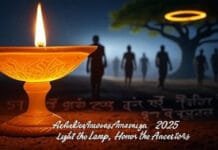INVC News
Haridwar : The Pitru Paksha, a sacred and spiritually significant period in Hinduism, is set to commence on September 29, 2023. This revered observance, spanning 15 days, holds a special place in the hearts of millions, for it is a time when families come together to pay homage to their ancestors, perform Shradh rituals, offer Tarpan, and seek blessings. In this comprehensive guide, we delve into the essence of Pitru Paksha, its rituals, and the importance it carries in the Hindu faith.
Understanding the Significance of Pitru Paksha
Pitru Paksha, also known as Pitripaksha or Shraadh, is a fortnight-long period that occurs annually in the Hindu calendar. It begins on the full moon day (Purnima) of the Bhadrapada month and concludes on the new moon day (Amavasya) of the Ashwin month. This time is often referred to as Sarva Pitru Amavasya, highlighting its importance in honoring departed ancestors.
During Pitru Paksha, families engage in Shradh rituals, which are a way of paying respects to their forefathers. It is believed that by performing these rituals, the souls of the deceased attain salvation and find peace. Additionally, the observance of Shradh seeks to invite the blessings of the ancestors into the lives of the living, fostering harmony and happiness within the family.
Rules and Rituals of Pitru Paksha
Shraddha, Pind Daan, and Tarpan
The heart of Pitru Paksha lies in its rituals, which include Shradh, Pind Daan, and Tarpan. These ceremonies are performed with great devotion to honor and remember one’s ancestors.
- Shradh: This is a solemn ritual where offerings are made to the ancestors. It involves the preparation of a special meal, known as Pind, which is offered to the departed souls. This act symbolizes the provision of nourishment to the ancestors’ souls, ensuring their well-being in the afterlife.
- Pind Daan: The Pind Daan ceremony is an integral part of Pitru Paksha. It is believed that by performing this ritual on the specific date corresponding to the anniversary of an ancestor’s death, their soul is liberated, and they attain moksha (liberation from the cycle of rebirth).
- Tarpan: Tarpan involves offering water and prayers to the ancestors. It is believed that this act satisfies their spiritual thirst and brings blessings to the living family members.
Communion with Ancestors
One of the deeply cherished beliefs during Pitru Paksha is that the spirits of the ancestors visit the earthly realm to reunite with their family. This is a time for the living to communicate with the departed through the rituals and ceremonies performed with utmost devotion.
15 Special Days of Pitru Paksha 2023
Pitru Paksha spans 15 days, each with its significance. The observance includes performing Shradh and Pind Daan on specific dates, which are determined based on the lunar calendar. Here are the dates for Pitru Paksha 2023:
- September 29: Purnima Shraddha
- September 30: Pratipada Shraddha, Dwitiya Shraddha
- October 1: Tritiya Shradh
- October 2: Chaturthi Shradh
- October 3: Panchami Shradh
- October 4: Shashthi Shraddha
- October 5: Saptami Shraddha
- October 6: Ashtami Shraddha
- October 7: Navami Shraddha
- October 8: Dashami Shradh
- October 9: Ekadashi Shradh
- October 11: Dwadashi Shradh
- October 12: Trayodashi Shraddha
- October 13: Chaturdashi Shradh
- October 14: Sarva Pitra Amavasya
Performing Shradh and Pind Daan on these specific dates is believed to secure the blessings and protection of the ancestors throughout the year.
In Conclusion
Pitru Paksha 2023 is an occasion of immense spiritual significance, providing families with an opportunity to honor their ancestors, seek their blessings, and ensure their well-being in the afterlife. It is a time when the bonds between the living and the departed are strengthened, fostering peace and harmony within families.
As you prepare to observe Pitru Paksha, remember the importance of these rituals and the deep-rooted beliefs that guide them. By performing Shradh, Pind Daan, and Tarpan with sincerity and devotion, you honor your forefathers and continue a sacred tradition that has endured for generations.















